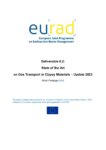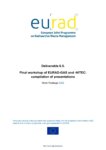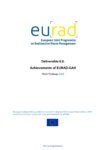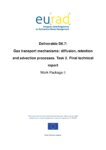GAS: Mechanistic understanding of gas transport in clay materials (EURAD WP)
Project Dates: 1st June 2019 – 30 May 2024
Project Status: Finished
Project Website: https://www.ejp-eurad.eu/implementation/mechanistic-understanding-gas-transport-clay-materials-gas
GAS was an RD&D Work Package (WP) within EURAD. It aimed to increase understanding and predictability of gas migration in different host rocks.
Overview
Within Theme 4 of the EURAD Roadmap (Geoscience to understand rock properties, radionuclide transport and long-term geological evolution), improving the understanding of gas migration was listed as a high priority topic. Gas generation and transport is a key issue as it is possible that gas could be generated at a faster rate than it can be removed through clay host rocks (and clay EBS components – Theme 3) without creating discrete, gas-specific pathways through these low-permeability components. In several disposal concepts, the potential for migration of free gas containing radionuclides to the biosphere is an important issue. Consequently, the raison d’être of this WP was to answer two key end-users questions:
- How can gas migrate within the repository and which water soluble and volatile radionuclides could be associated with it?
- How and to what extend could the hydro-mechanical perturbations induced by gas affect barrier integrity and performance?
This WP built on the outcomes of FORGE. Experiments in FORGE revealed complex mechanisms and emphasized the importance of the mechanical control exerted by the porous material on gas transport. It was suggested that this complexity can be addressed as long as one can bound the effects of these mechanisms using simple and robust descriptions for evaluation purposes (e.g. two-phase flow models for gas transient representation at repository scale, identified as a medium priority under Theme 4). A necessary condition for this is that the scientific bases are integrated properly, in a traceable way throughout the system conceptualisation process. Hence, the structure of this WP followed this process, imposing interactions at each step to ensure close cooperation between experimentalists, process modellers and those involved in evaluation of system performance. This should allow the development of robust evaluation approaches that support the expert judgement formulated at the end of FORGE that gas is not a feasibility challenging issue for geological disposal but more a challenge of managing uncertainties.
Objective
This WP provided data and developed process-level models to improve mechanistic understanding of transport processes in natural and engineered clay materials, including couplings with mechanical behaviour and impact on the clay properties. Experimental work determined, for each identified gas transport regime, the conditions under which that regime is possible, in clay materials representative of host rock and clay EBS components. Data was obtained that are pertinent for low (diffusion) to high (advection) gas transport rates.
Work also showed how knowledge gained from lab and in situ experiments is integrated in the conceptualisation of gas transport through different components of a repository system and how gas could affect (or not) the performance of the system. This involved (i) development of phenomenological descriptions of gas transport and of its likely consequences at the relevant scale and (ii) testing different approaches to represent the effects of gas at repository scale and bounding its consequences in terms of repository performance.
Outcomes
EURAD-GAS has increased confidence in the overall understanding of gas behavior in clayey materials, building on the FORGE EC project and beyond. This has in turn improved its integration into the conceptualization process for the different components of a disposal system, supporting and justifying
the use of robust evaluation approaches. Overall, the discussion among all members of EURAD-GAS, including research entities, technical support organizations, and waste management organizations, has helped to strengthen the expert judgment at the end of FORGE: gas is not a showstopper for geological
disposal, but rather requires effective management of uncertainties.
The impacts of EURAD-GAS can be categorized in terms of implementation needs for geological disposal, safety of geological disposal systems, and increased of scientific and technical knowledge:
- In terms of implementation needs for geological disposal: EURAD-GAS has produced documents for implementers that can inspire design measures to further reduce the gas impacts, or uncertainties associated with gas transport through geological disposal systems. Two state-of-the art reports have been written. The first one presents some fundamentals on gas transport in clayey materials (Levasseur et al., 2021) while the second focuses on key messages for end-users such as program managers (Levasseur et al., 2024).
- In terms of safety: EURAD-GAS has provided experimental evidence on the processes involved in gas transport throughout a disposal system and on the effects of these processes on barrier materials (Jacops and Kolditz, 2024; Marschall et al., 2024). This evidence can be referred to by national programs in the arguments supporting claims about long-term safety of a geological system. EURAD-GAS had also collected elements that make it possible to identify the inherent strengths and limitations of various approaches for the treatment of gas in safety cases and to assess their suitability in different contexts, recognizing that this may depend on the disposal
system that is being evaluated (host rock/design) or even the advancement of the (national) program (Wendling et al., 2024). Similarities of approaches between national programs were identified and the rationale behind differences explained (Levasseur et al., 2021). - In terms of increased scientific and technical knowledge: EURAD-GAS has succeeded in bridging the gap between experimentalists and modelers. Building on the lessons learned from the FORGE EC project, modelers were embedded with the experimentalists to encourage dialogue in the design of experiments and the development of shared conceptualizations of the observed behavior (Jacops and Kolditz, 2024; Marschall et al., 2024). By doing so, EURAD-GAS has built confidence and extended the scientific bases on the fundamentals of gas transport in clayey materials. It has confirmed that the fundamental gas transport mechanisms that can develop in different clays are similar. Because a wide enough, but realistic, range of conditions were explored for representative clayey materials, EURAD-GAS has provided data which are of relevance for all disposal systems that include clayey barriers. Testing over a range of conditions spanning low (diffusion) to high (advection) gas generation rates, a better understanding of processes has been acquired which then has broader end-users’ appeal. This understanding is described in the final technical reports (Jacops and Kolditz, 2024; Marschall et al., 2024; Wendling et al., 2024).












